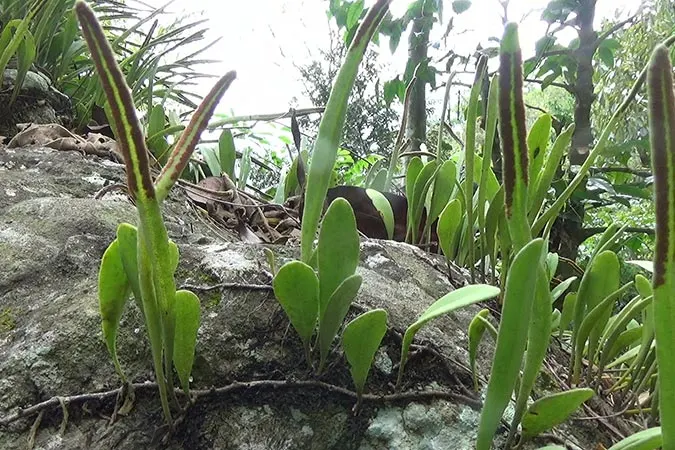Pakis lidah or tongue fern (Pyrrosia adnascens) is a plant species in the Polypodiaceae, a long creeping rhizome, up to 1 mm thick, in cross-section usually with a single central sclerenchyma strand, the distance between phyllopodia is 1-2 cm and lateral shoots alternate with phyllopodia.
P. adnascens has peltate scales, 3-5x1 mm, all over the base to the ciliate. Light brown tips, often with distinct hyaline and ciliate margins. Dimorphic midrib. The sterile frond has a stalk of 1-1.5 cm. Lamina 1-6x1-2 cm, cuneate base and rounded tip.
The fertile midrib gradually narrows at the base to the stem for a length of 5 cm. Lamina 8-25-0.45-0.8 cm, blunt tip to acute. Hydathodes appear rarely, few and are not clear. Monomorphic indumen but rarely, whitish to brown in color. Long hair 0.2-1.2 mm. Sori sinks with the central bundle of paraphyses.
Tongue fern grows on the trunks of living trees, dead trees and rocks at an altitude of 0-1300 m. Generally grows in humid areas and can withstand drought for up to 6 months. The whole plant is used in traditional Chinese medicine.
Kingdom: Plantae
Phylum: Tracheophyta
Class: Polypodiopsida
Subclass: Polypodiidae
Order: Polypodiales
Suborder: Polypodiineae
Family: Polypodiaceae
Subfamily: Platycerioideae
Genus: Pyrrosia
Species: Pyrrosia adnascens
Form: Pyrrosia adnascens f. adnascens, Pyrrosia adnascens f. calcicola
P. adnascens has peltate scales, 3-5x1 mm, all over the base to the ciliate. Light brown tips, often with distinct hyaline and ciliate margins. Dimorphic midrib. The sterile frond has a stalk of 1-1.5 cm. Lamina 1-6x1-2 cm, cuneate base and rounded tip.
The fertile midrib gradually narrows at the base to the stem for a length of 5 cm. Lamina 8-25-0.45-0.8 cm, blunt tip to acute. Hydathodes appear rarely, few and are not clear. Monomorphic indumen but rarely, whitish to brown in color. Long hair 0.2-1.2 mm. Sori sinks with the central bundle of paraphyses.
Tongue fern grows on the trunks of living trees, dead trees and rocks at an altitude of 0-1300 m. Generally grows in humid areas and can withstand drought for up to 6 months. The whole plant is used in traditional Chinese medicine.
Kingdom: Plantae
Phylum: Tracheophyta
Class: Polypodiopsida
Subclass: Polypodiidae
Order: Polypodiales
Suborder: Polypodiineae
Family: Polypodiaceae
Subfamily: Platycerioideae
Genus: Pyrrosia
Species: Pyrrosia adnascens
Form: Pyrrosia adnascens f. adnascens, Pyrrosia adnascens f. calcicola
